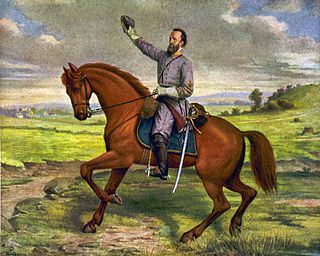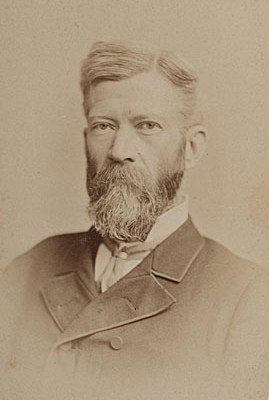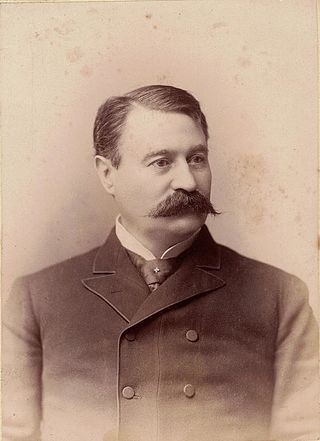
The First Battle of Winchester, fought on May 25, 1862, in and around Frederick County, Virginia, and Winchester, Virginia, was a major victory in Confederate Army Maj. Gen. Thomas J. "Stonewall" Jackson's Campaign through the Shenandoah Valley during the American Civil War. Jackson enveloped the right flank of the Union Army under Maj. Gen. Nathaniel P. Banks and pursued it as it fled across the Potomac River into Maryland. Jackson's success in achieving force concentration early in the fighting allowed him to secure a more decisive victory which had escaped him in previous battles of the campaign.

Jackson's Valley campaign, also known as the Shenandoah Valley campaign of 1862, was Confederate Maj. Gen. Thomas J. "Stonewall" Jackson's spring 1862 campaign through the Shenandoah Valley in Virginia during the American Civil War. Employing audacity and rapid, unpredictable movements on interior lines, Jackson's 17,000 men marched 646 miles (1,040 km) in 48 days and won several minor battles as they successfully engaged three Union armies, preventing them from reinforcing the Union offensive against Richmond.

The First Battle of Kernstown was fought on March 23, 1862, in Frederick County and Winchester, Virginia, the opening battle of Confederate Maj. Gen. Thomas J. "Stonewall" Jackson's campaign through the Shenandoah Valley during the American Civil War.
The Battle of McDowell, also known as the Battle of Sitlington's Hill, was fought on May 8, 1862, near McDowell, Virginia, as part of Confederate Major General Stonewall Jackson's 1862 Shenandoah Valley campaign during the American Civil War. After suffering a tactical defeat at the First Battle of Kernstown, Jackson withdrew to the southern Shenandoah Valley. Union forces commanded by Brigadier Generals Robert Milroy and Robert C. Schenck were advancing from what is now West Virginia towards the Shenandoah Valley. After being reinforced by troops commanded by Brigadier General Edward Johnson, Jackson advanced towards Milroy and Schenck's encampment at McDowell. Jackson quickly took the prominent heights of Sitlington's Hill, and Union attempts to recapture the hill failed. The Union forces retreated that night, and Jackson pursued, only to return to McDowell on 13 May. After McDowell, Jackson defeated Union forces at several other battles during his Valley campaign.

The Battle of Front Royal, also known as Guard Hill or Cedarville, was fought on May 23, 1862, during the American Civil War, as part of Jackson's Valley campaign. Confederate forces commanded by Major General Thomas J. "Stonewall" Jackson were trying to keep Union forces engaged in the Shenandoah Valley to prevent them from joining the Peninsula campaign. After defeating Major General John C. Frémont's force in the Battle of McDowell, Jackson turned against the forces of Major General Nathaniel Banks.

John Daniel Imboden, American lawyer, Virginia state legislator, and a Confederate army general. During the American Civil War, he commanded an irregular cavalry force. After the war, he resumed practicing law, became a writer, and was active in land development founding the town of Damascus, Virginia.
The Stonewall Brigade of the Confederate Army during the American Civil War, was a famous combat unit in United States military history. It was trained and first led by General Thomas J. "Stonewall" Jackson, a professor from Virginia Military Institute (VMI). His severe training program and ascetic standards of military discipline turned enthusiastic but raw recruits into an effective military organization, which distinguished itself from the First Battle of Bull Run in 1861 to Spotsylvania Court House in 1864. Its legacy lives on in the 116th Infantry Brigade, which bears the unofficial nickname "Stonewall Brigade," and in several living history reenactment groups.

Foot cavalry was an oxymoron coined by the media to describe the rapid movements of infantry troops serving under Confederate General Thomas Jonathan "Stonewall" Jackson during the American Civil War. Jackson's men marched on foot but they were able to cover long distances day after day to surprise the enemy.

James Alexander Walker was a Virginia lawyer, politician, and Confederate general during the American Civil War, later serving as a United States Congressman for two terms. He earned the nickname "Stonewall Jim" for his days as commander of the famed Stonewall Brigade. Walker is the first graduate of the Virginia Military Institute to serve as Lieutenant Governor of Virginia. He was expelled from the Institute weeks before graduation in 1852 amidst a bitter dispute with then-mathematics professor Thomas Jackson, but was granted his degree in 1872 in recognition of his military service in the American Civil War.

The Virginia Hotel was built in 1847 in Staunton, Virginia, and quickly became known as one of the finest hostelries in the commonwealth. Built on the site of the old Washington Tavern, the northeast corner of Greenville Avenue at New Street, the Virginia Hotel gained fame during the American Civil War as the headquarters of Stonewall Jackson, and served, alternately, as a hospital for Confederate soldiers and as headquarters for conquering Union Gen. David Hunter. It also served as a meeting point for several U.S. Presidents.
John Quincy Adams Nadenbousch was a businessman, Confederate officer during the American Civil War and local politician in Martinsburg, West Virginia.
Kenton Harper was an American newspaper editor, soldier, Indian agent, plantation owner, banker and politician. An officer of the Virginia militia then U.S. Army during the Mexican–American War, Harper later became a Confederate general officer during the American Civil War, and reportedly helped nickname Stonewall Jackson.

Robert Doak Lilley was a Confederate brigadier general during the American Civil War. He served in most of the leading battles of the Army of Northern Virginia and led a brigade of infantry in the Shenandoah Valley in the last years of the war.
William Henry Harman was a brigadier general in the Virginia militia and colonel in the Confederate States Army during the American Civil War, who was killed in action during the Battle of Waynesboro, Virginia, on March 2, 1865.

Augustus John Turner,, known as "A. J. Turner", was an American composer, band leader and music professor.

Charles William Turner was a lawyer in Seattle and Montana, and once Adjutant General of Montana. As a youth during the American Civil War, he was a courier for Stonewall Jackson. Subsequently, he was one of the VMI cadets who fought at the Battle of New Market. He later moved to Montana to practice law and engaged in mining pursuits. Turner was shot to death in a Seattle bar by an assassin who was after one of Turner's clients.

Thomas Memory Turner was an American composer, band leader, and music professor. He was known to his friends as "Mem".
Gypsy Hill Park is a recreational park situated in the center of Staunton, Virginia, United States, where Churchville Avenue and Thornrose Avenue intersect. The park contains various public services and attractions, including football and baseball fields, the Thomas D. Howie Memorial National Guard Armory, a large bandstand pavilion, a golf course, a basketball court, a gym, and the central duck pond equipped with food dispensers, allowing visitors to feed the ducks and fish. Throughout the park are picnic tables, grills and covered pavilions. Constitution Drive, an almost 1+1⁄2-mile-long (2.4 km) road, runs through the park and is often used as a walking and bike path.
Edwin Merrill "Ned" Cushing was an American tenor horn player, auctioneer, and coroner in Staunton, Virginia. Cushing was a charter member and first president of the Stonewall Brigade Band. He was considered a "veritable encyclopedia" of Staunton's town history. He was a town alderman in 1853, 1854, and 1856. His gavel is still kept.
David William Drake was a farmer, musician and the founder of the Stonewall Brigade Band. He began the band with Edwin Cushing, and recruited A. J. Turner as the band's first director. Drake moved to Staunton, Virginia in 1854. He married Kate Murat Slaughter, of Rappahannock County, on April 15, 1868. The band became part of the 5th Virginia Infantry Regiment. He played a bugle, and was in the West Augusta Guard before the band, and later in the 1st Virginia Cavalry. Jeb Stuart commended his volunteering to perform hazardous scouting duties across the Rappahannock River.













